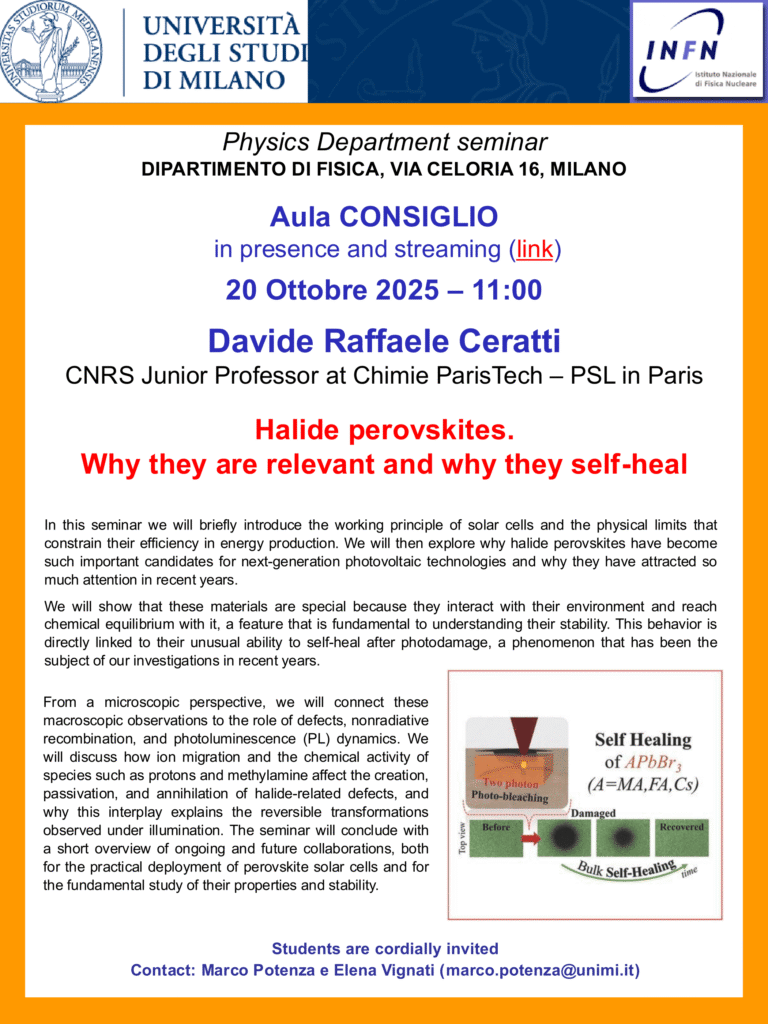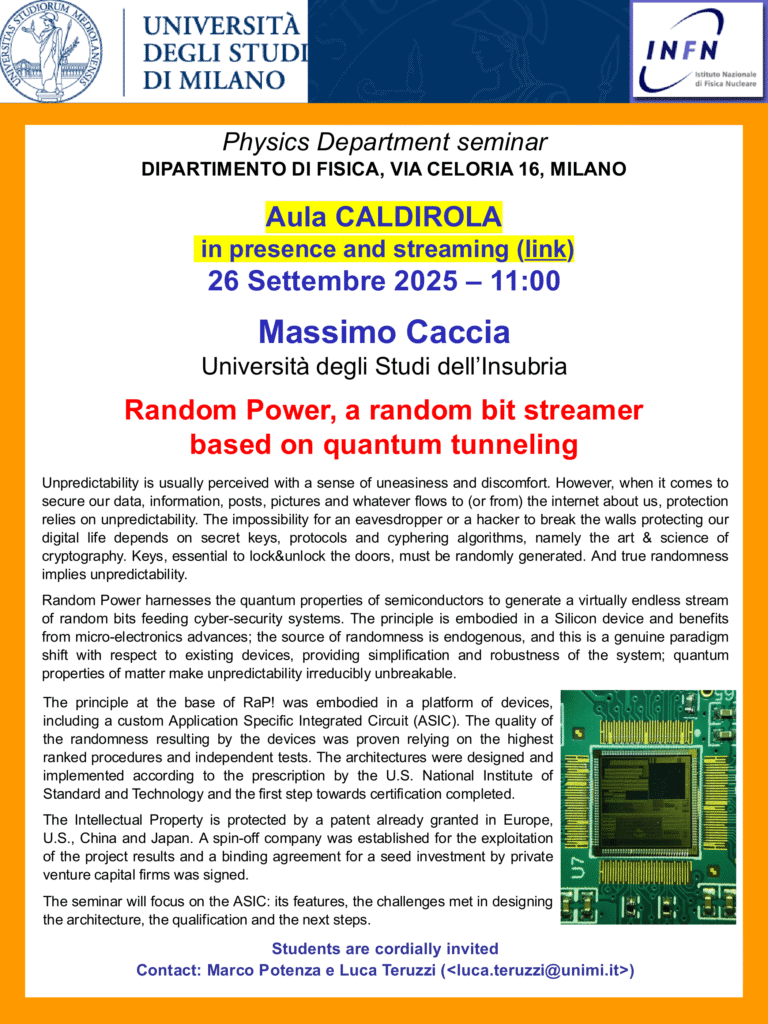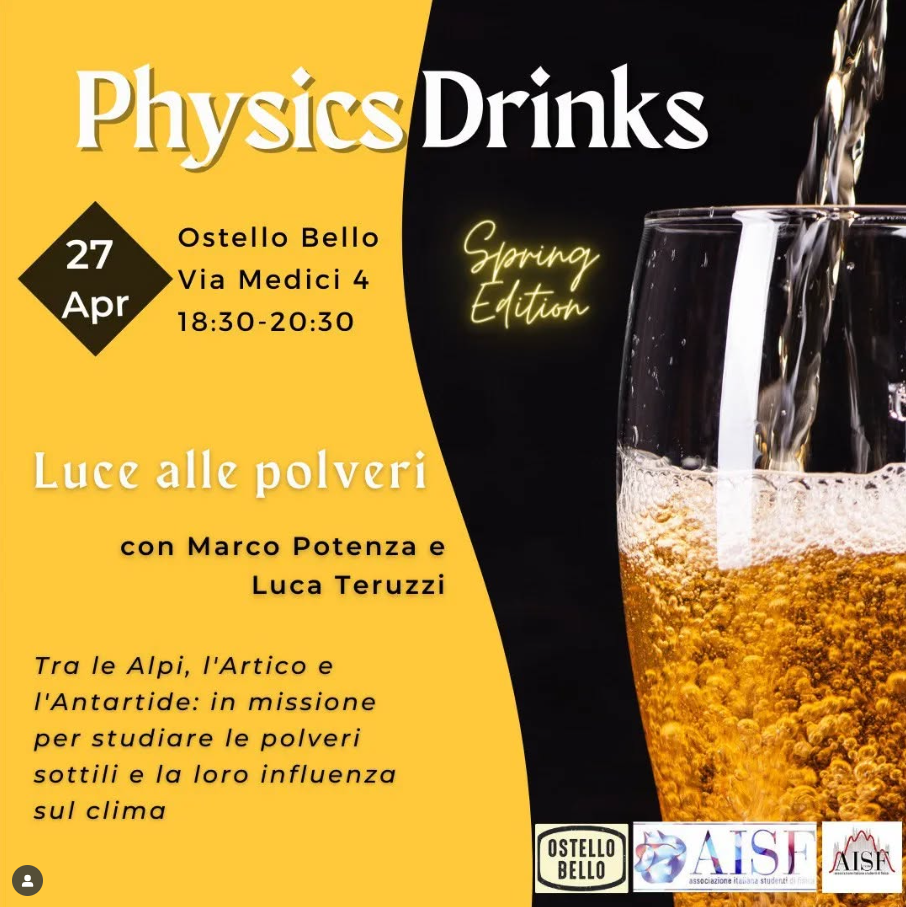Halide perovskites. Why they are relevant and why they self-heal – prof. Davide Raffaele Ceratti
Abastract: In this seminar we will briefly introduce the working principle of solar cells and the physical limits that constrain their efficiency in energy production. We will then explore why halide perovskites have become such important candidates for next-generation photovoltaic technologies and why they have attracted so much attention in recent years. We will show that these materials are special because they interact with their environment and reach chemical equilibrium with it, a feature that is fundamental to understanding their stability. This behavior is directly linked to their unusual ability to self-heal after photodamage, a phenomenon that has been the subject of our investigations in recent years. From a microscopic perspective, we will connect these macroscopic observations to the role of defects, nonradiative recombination, and photoluminescence (PL) dynamics. We will discuss how ion migration and the chemical activity of species such as protons and methylamine affect the creation, passivation, and annihilation of halide-related defects, and why this interplay explains the reversible transformations observed under illumination. The seminar will conclude with a short overview of ongoing and future collaborations, both for the practical deployment of perovskite solar cells and for the fundamental study of their properties and stability.

Speaker: prof. Davide Raffaele Ceratti, CNRS – Chimie Paris Tech
Location: Aula Consiglio, Physics Department “A. Pontremoli” of the University of Milan
When: 11:00, 20 October 2025, official link: Halide perovskites. Why they are relevant and why they self-heal – Raffaele Ceratti | Dipartimento di Fisica “Aldo Pontremoli”
Contacs:
- Marco A. C. Potenza, marco.potenza@unimi.it
- Elena Vignati, elena.vignati@unive.it
From Light to Nano
The “From Light to Nano” conference, held on 29–30 September 2025 at Università Cattolica del Sacro Cuore in Brescia, explores the complex interactions between light and nano- or micro-sized objects. The event focuses on both the experimental and theoretical challenges that arise when the dimensions of these objects are comparable to the wavelength of light, going beyond traditional models such as Mie theory. Bringing together researchers from diverse disciplines, the conference aims to foster discussion on advanced optical characterization, imaging methods, and modelling techniques applicable to biological systems, nanoplastics, and other nanostructured materials. Its central goal is to bridge insights from different scientific fields to improve understanding and measurement of light–matter interactions at the nanoscale.

Speakers:
- Maxim YURKIN, CORIA laboratory, Rouen (France)
- Dario POLLI, University of Milan (Italy)
- Romain CEOLATO, Université de Toulouse (France)
- Paolo BIANCHINI, IIT Genova (Italy)
- Masaru KUNO, Notre Dame University (Indiana, USA)
- Andrea VALSESIA, Joint Research Centre: EU Science Hub
- Andrea BALDI, VU Amsterdam (Netherlands)
- Michele ORTOLANI, La Sapienza University, Rome (Italy)
- Marco LEONETTI, CNR, Rome (Italy)
- Michael DI GIOACCHINO, Roma 3 University, Rome (Italy)
- Pietro VAHRAMIAN, EOS instruments Milan (Italy)
Location: Università Cattolica del Sacro Cuore, Via della Garzetta 48, 25123, (BS, Italy)
When: from 29 to 30 September 2025, official link: From light to nano – Brescia | Università Cattolica
Random Power, a random bit streamer based on quantum tunneling – prof. Massimo Caccia
Abstract: Unpredictability is usually perceived with a sense of uneasiness and discomfort. However, when it comes to secure our data, information, posts, pictures and whatever flows to (or from) the internet about us, protection relies on unpredictability. The impossibility for an eavesdropper or a hacker to break the walls protecting our digital life depends on secret keys, protocols and cyphering algorithms, namely the art & science of cryptography. Keys, essential to lock&unlock the doors, must be randomly generated. And true randomness implies unpredictability. Random Power harnesses the quantum properties of semiconductors to generate a virtually endless stream of random bits feeding cyber-security systems. The principle is embodied in a Silicon device and benefits from micro-electronics advances; the source of randomness is endogenous, and this is a genuine paradigm shift with respect to existing devices, providing simplification and robustness of the system; quantum properties of matter make unpredictability irreducibly unbreakable.
The principle at the base of RaP! was embodied in a platform of devices, including a custom Application Specific Integrated Circuit (ASIC). The quality of the randomness resulting by the devices was proven relying on the highest ranked procedures and independent tests. The architectures were designed and implemented according to the prescription by the U.S. National Institute of Standard and Technology and the first step towards certification completed. The Intellectual Property is protected by a patent already granted in Europe, U.S., China and Japan. A spin-off company was established for the exploitation of the project results and a binding agreement for a seed investment by private venture capital firms was signed. The seminar will focus on the ASIC: its features, the challenges met in designing the architecture, the qualification and the next steps.
Speaker: prof. Massimo Luigi Maria Caccia, Università degli Studi dell’Insubria
Location: Aula Caldirola, Physics Department “A. Pontremoli” of the University of Milan
When: 11:00, 26 September 2025, official link: Random Power, a random bit streamer based on quantum tunneling – Massimo Caccia | Dipartimento di Fisica “Aldo Pontremoli”
Contacs:
- Marco A. C. Potenza, marco.potenza@unimi.it
- Luca Teruzzi, luca.teruzzi@unimi.it

Effects of light-absorbing aerosols
Abstract: The effect of light-absorbing particles on climate is still poorly bounded and quantified. Among the strongest light-absorbing and most harmful aerosols are black and brown carbon particles produced by the combustion of fossil fuels or wildfires. The direct and indirect effects of these particles are strongly related to their optical properties. Locally, they warm the layer of the atmosphere surrounding them and modify the thermodynamic equilibrium of clouds, their albedo, and droplet size distribution. They also accelerate the degradation of the cryosphere, reducing the Earth’s surface albedo and affecting the hydrological cycle. Overall, their effects amount to a positive forcing that adds to that of greenhouse gases; however, leading order uncertainties are still limiting the accuracy with which to quantify their role in the climate system. In this seminar, Professor Mazzoleni will provide an overview of the main challenges associated with measuring and modelling the properties of light-absorbing aerosols and review the contributions to this field made by his group and collaborators.
Speaker: prof. Claudio Mazzoleni, Michigna Technological University
Location: Aula Caldirola, Physics Department “A. Pontremoli” of the University of Milan
When: 11:00, 19 June 2025
Contacs:
- Marco A. C. Potenza, marco.potenza@unimi.it
- Llorenç Cremoensi, llorenc.cremonesi@unimi.it

Ai confini del mondo: il Sole senza tempo dell’Antartide
Abstract: Si potrebbe pensare che il Sole sia già stato studiato e osservato in ogni modo possibile; tuttavia, non è così. Eventi come brillamenti ed espulsioni di massa coronale possono ancora celare molti aspetti sconosciuti. Di particolare interesse sono tutti quei fenomeni precursori di tempeste geomagnetiche e, più in generale, tutti gli eventi legati alle interazioni Sole-Terra. SOLARIS è un progetto scientifico e tecnologico finalizzato allo sviluppo di un sistema intelligente di monitoraggio solare ad alte frequenze radio (100 GHz) basato su tecniche di imaging a singola parabola, e le eccezionali condizioni di opacità e stabilità atmosferica offerte dall’Antartide offrono un laboratorio naturale unico nel suo genere. A questo scopo, durante la campagna appena conclusasi, abbiamo totalmente restaurato il telescopio OASI presso la stazione Mario Zucchelli. In prospettiva, le stesse azioni verranno replicate il prossimo anno anche presso la stazione Italo-francese Concordia, al centro del plateau Antartico, nel corso della 41° Spedizione Italiana in Antartide.
Speaker:
- dott. Luca Teruzzi, Physics Department of the University of Milan
- Francesco Cavaliere, head of the Mechanical Workshop of the Physics Department (Unimi)
Location: Ostello Bello, via Medici 4, 20123 Milan (MI, Italy)
When: 18:30, 9 April 2025

Luce alle polveri – Tra le Alpi, l’Artico e l’Antartide: in missione per studiare le polveri sottili e la loro influenza sul clima
Speaker:
- dott. Luca Teruzzi, Physics Department of the University of Milan
- prof. Marco A. C. Potenza, head of the Instrumental Optics lab of the Physics Department (Unimi)
Location: Ostello Bello, via Medici 4, 20123 Milan (MI, Italy)
When: 18:30, 27 April 2023
